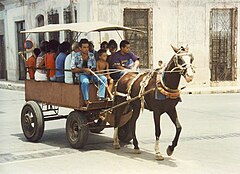This article has multiple issues. Please help improve it or discuss these issues on the talk page. (Learn how and when to remove these messages)
|
| Special Period Periodo especial | |
|---|---|
 Cuban citizens resorting to horse-drawn carriage for transportation (1994) | |
| Country | Cuba |
| Period | 1991–2000 |
| Refugees | Around 30,000 |
| Effect on demographics |
|
| Consequences |
|
| History of Cuba |
|---|
 |
| Governorate of Cuba (1511–1519) |
|
|
| Viceroyalty of New Spain (1535–1821) |
|
|
| Captaincy General of Cuba (1607–1898) |
|
|
| US Military Government (1898–1902) |
|
|
| Republic of Cuba (1902–1959) |
|
|
| Republic of Cuba (1959–) |
|
|
| Timeline |
|
|
|
|
The Special Period (Spanish: Período especial), officially the Special Period in the Time of Peace (Período especial en tiempos de paz), was an extended period of economic crisis in Cuba that began in 1991[1] primarily due to the dissolution of the Soviet Union and the Comecon. The economic depression of the Special Period was at its most severe in the early to mid-1990s. Things improved towards the end of the decade once Hugo Chávez's Venezuela emerged as Cuba's primary trading partner and diplomatic ally, and especially after the year 2000 once Cuba–Russia relations improved under the presidency of Vladimir Putin.
Privations during the Special Period included extreme reductions of rationed foods at state-subsidized prices, severe energy shortages, and the shrinking of an economy forcibly overdependent on Soviet imports.[2] The period radically transformed Cuban society and the economy, as it necessitated the introduction of organic agriculture, decreased use of automobiles, and overhauled industry, health, and diet countrywide. People were forced to live without many goods and services that had been available since the beginning of the 20th century.
- ^ Henken, Ted (2008). Cuba: A Global Studies Handbook. ABC-CLIO. p. 438. ISBN 9781851099849. Archived from the original on 24 January 2023. Retrieved 30 June 2014 – via Google Books.
- ^ Garth, Hanna (23 March 2017). ""There is no food": Coping with Food Scarcity in Cuba Today". Society for Cultural Anthropology. Archived from the original on 13 June 2017. Retrieved 9 August 2020.